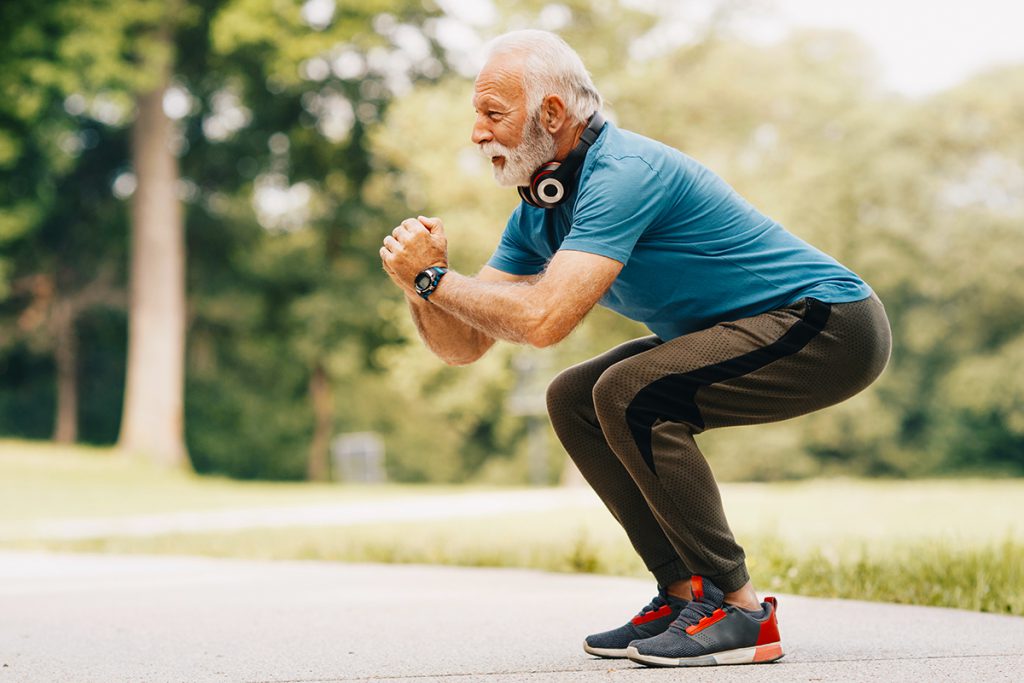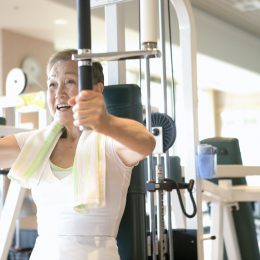Squats Hurt Your Lower Back? Try This!
Squats are one of the best exercises you can do—if they don’t cause pain. Here’s why they might, plus how to fix it.

It’s no coincidence that squats seem to pop up in almost every workout.
The exercise is worth doing at every stage of life because it’s functional, meaning it gets you moving in a way that directly translates to everyday activities, says Theresa Marko, D.P.T., an orthopaedic physical therapist who works with older adults. For example, you need to be able to squat to get up from a chair or use the toilet, she says.
But squats don’t just mimic everyday movements. They also strengthen the muscles you need to continue doing them independently—namely, the quadriceps in the front of your thighs and the glutes, which often weaken with age.
“People tend to lose muscle mass in their glutes as they get older due to a more sedentary lifestyle,” Marko says. “The muscles get overstretched and weak, but squats can help counteract the effects of more time spent sitting.”
The only problem: For many people, squats trigger back pain and discomfort, which can quickly negate the benefits if it leads to poor form.
The solution isn’t necessarily to skip squats altogether. Instead, take some time to consider what might be causing pain during this important exercise. Here are four common culprits, plus potential fixes to help you keep reaping the many benefits of squats.
Get and stay fit with SilverSneakers! Choose from dozens of different Community classes, visit a participating fitness location, or join one of our 20+ SilverSneakers LIVE online classes. Check your eligibility here.
Reason #1: You Have Tight Hips
“I find hip mobility to be a huge challenge for many older adults,” says Laura Flynn Endres, a certified personal trainer who specializes in senior fitness.
Anyone who spends a lot of time sitting—no matter your age—is familiar with how tight it can make your hips. But on top of that, the ligaments in the hips tend to stiffen with age, Endres says. Plus, normal changes in activity may mean you’re not doing as much hip mobility work as you did when you were younger.
What does this have to do with squats? Without enough hip mobility, it can be difficult to lower into a squat without compromising your form, Endres says. That might mean rounding or arching your spine, which puts more pressure on it.
Try This: Experiment with Your Squat Stance
“We’ve discovered that everyone has slightly different hip anatomy,” Endres says. Standing with your feet a little farther apart or closer together may feel better and make it easier to lower into a squat with good form, she says. You can also try turning your toes out slightly instead of pointing them directly forward.
Even if tweaking your stance helps, it’s also a good idea to incorporate some mobility training into your regular workout. Try this quick stretch routine for your hips.
Reason #2: Your Backside Is Weak
Full squats require a base level of glute and core strength to maintain proper form, Endres says. And if you lack that strength, your body may shift the brunt of the work to the lower back to compensate for weakness in the glutes.
Over time, the added stress on your lower back builds up, which can lead to soreness, pain, and possibly injury—both when you squat and otherwise.
“Many people just don’t have the glute strength to do deep squats,” she says. After all, lowering down, keeping the spine straight and stable, and then using all those muscles to stand back up again is pretty demanding on your lower body.
Try This: Start with the Sit-to-Stand
If you think your glutes might need some attention, start with the sit-to-stand exercise to build the strength you need for full squats.
How to do it: Sit on the edge of a sturdy chair with your feet flat on the floor. Rest your arms on your hips, cross them at your shoulders, or hold them in front of you for counterbalance.
Push down through your feet to stand up, keeping your chest up and trying not to use your arms for help. Pause, then slowly lower back down. That’s one rep. Aim for eight to 10 reps total.
Plus, for more exercises to help you work up to a full squat, check out how to build strength and confidence from a seated position.
Reason #3: You’re Only Going Through the Motions
For some people, a lack of strength isn’t the issue, but rather they’re not practiced at activating the right muscles.
The mind-body connection of exercise, or the practice of thinking about the muscles that need to be engaged, isn’t always automatic. In fact, Endres says many of her clients are confused when she mentions it.
“Awareness is the problem for about half of my clients,” she says. “If I can get them aware of the correct muscles, then they say, ‘Oh! Now I see what you mean.’”
Try This: Think About Using the Right Muscles
When you squat, actively focus on keeping your core engaged throughout the entire movement.
Not sure what that means? Picture everything from your rib cage to your pelvis, glutes included. When your core is engaged, it should feel like a single, strong cylinder.
Subscribe to our newsletter
It's quick and easy. You could be one of the 13 million people who are eligible.
Already a member? Click to discover our 15,000+ participating locations.
Follow Us
Another way to think about it: Imagine someone comes and tries to push you over. If your core is activated, or engaged, it means the muscles are contracted enough that your core would help you stay upright at any point during the movement.
Reason #4: Your Squat Is Actually More of a Hip Hinge
Squatting and hip hinging are not the same movement, but many people confuse them or do them at the same time, Endres says.
A hip hinge involves bending forward at the hips, pushing your glutes behind you, and keeping your spine straight so that your torso ends up nearly parallel to the floor.
A squat, on the other hand, involves only a slight bend at the hips. The bulk of the movement is bending your knees to lower down as you keep your torso upright. Your torso may angle forward slightly to prevent any arching of the back, but it’s a much more subtle forward movement than a hip hinge.
“If you squat and hinge at the same time, your lower back is going to feel some pressure,” Endres says.
Try This: Trade Squats for a Modified Sit-to-Stand
If you bend forward or find yourself looking down at the floor when you squat, try a powered-up version of the sit-to-stand exercise instead. It’s the same movement pattern as a traditional sit-to-stand, except you start by sitting in a chair with your arms hanging at your sides.
When you press through your heels to stand up, swing your arms in front of you to help power the motion as you do. This little oomph from the arms can help you resist the urge to hinge forward, Endres says.
Still Have Pain?
Exercise is meant to make you feel better, not worse. If you try these fixes and squats are still painful, stop experimenting on your own, and talk with a physical therapist. They can help assess your movement patterns and get to the bottom of what’s causing pain.
Once you know the cause, it’s much easier to figure out a solution that makes sense for you, which might mean doing alternative exercises that offer similar strength and mobility benefits—without pain.
Take Your Favorite SilverSneakers Classes Online!
SilverSneakers members can access live fitness classes and wellness workshops through SilverSneakers LIVE. See the latest schedule and RSVP for classes here.
Not a member? If you have a Medicare Plan, it may include SilverSneakers—at no additional cost. Check your eligibility instantly here.





